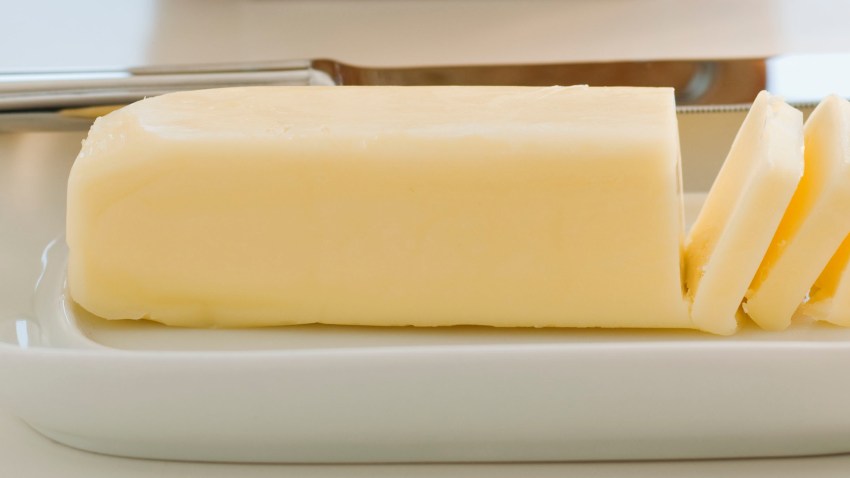The Reason We Eat Butter Instead of Margarine

So is margarine healthy? This article will take a closer look at the health benefits and risks of margarine vs. butter to help you determine which one is the better option.
What Is Margarine?
Margarine is a type of condiment that is commonly used for cooking and baking. It’s also used as a spread and can help add a bit of flavor to dishes.
The history of margarine can be traced back to 1869, when it was invented during a shortage of butter in France. It was first created by French chemist Hippolyte Mège-Mouriès and was originally made using beef tallow and skimmed milk.
READ ALSO: 10 Processed Foods that Will Slowly Kill You
So what is margarine made of today? Most types are made of vegetable oils, which are high in polyunsaturated fatty acids.
These vegetable oils are chemically altered through processes like hydrogenation or interesterification, which makes them more solid and spreadable, with a texture similar to butter.
Other margarine ingredients may include food additives like emulsifiers and coloring agents, which are used to modify the texture and appearance of the final product.
READ ALSO: Chemicals in your diet are a nightmare
What Is the Difference Between Butter and Margarine?
Butter is a dairy product made by churning milk. Meanwhile, margarine is a heavily processed ingredient made from vegetable oil that has been chemically altered in a lab.
The nutritional value of the two ingredients is also very different.
Because margarine is made of vegetable oil, it’s almost entirely composed of polyunsaturated fatty acids. Butter, on the other hand, is primarily saturated fat.
Certain varieties of butter, like grass-fed butter, are rich in several important nutrientsas well, including vitamin K2. Studies show that vitamin K2 could play a key role in bone strength, heart health and cancer prevention.
Butter is also rich in several important fatty acids, including butyrate, omega-3 fatty acids and conjugated linoleic acid.
Compared to butter, margarine is much lower in these essential nutrients. It often contains some fat-soluble vitamins like vitamin A and vitamin E, along with omega-6 fatty acids and small amounts of sodium.
Potential Benefits
Margarine is rich in polyunsaturated fatty acids, which are considered a heart-healthy form of fat. According to one study published in American Journal of Clinical Nutrition, swapping out saturated fats for polyunsaturated fats was associated with a lower risk of coronary heart disease.
Not only that, but it’s also rich in plant sterols and stanols. These compounds have been shown to reduce levels of bad LDL cholesterol, which is a major risk factor for heart disease.
Margarine is also a popular choice for those on a budget, as it’s typically much more cost-effective than butter or other types of cooking oils.
Many people also wonder: Is margarine vegan?
Margarine can be a good alternative to butter for those with specific dietary restrictions, including vegans. Because it’s made from vegetable oils instead of milk, it can also be enjoyed by those limiting dairy for personal reasons or health issues.
Is It Bad for You? Risks and Side Effects
Despite the potential health benefits of margarine, there are several important downsides to consider as well.
For starters, it’s a heavily processed ingredient. Studies show that eating more processed foods may be tied to a higher risk of cancer, heart disease and even death.
Is margarine plastic?
Although many have heard the expression, “margarine is one molecule away from plastic,” this isn’t completely true.
Many compounds share similar structures and chemical compounds, but even slight variations can vastly alter the final product. Therefore, while it is definitely a highly processed ingredient, it is not the same as plastic.
Another important consideration is the amount of omega-6 fatty acids that it contains. While we do need a mix of both omega-3 and omega-6 fatty acids in our diets, getting the right ratio of these fats is crucial to protecting against inflammation and disease.
Unfortunately, most of us get way too many omega-6 fatty acids in our diets and not enough omega-3s. Although some research suggests that a ratio of 1:1 is ideal for these fatty acids, the ratio in the average western diet is closer to around 15:1.
Some types of margarine also undergo a process called hydrogenation, which alters the texture and helps solidify the oils. Unfortunately, this process also results in the formation of trans fatty acids, which are a type of harmful fat that can contribute to chronic conditions, such as cancer, heart disease, obesity and diabetes.
Most manufacturers have started switching to other processes, like interesterification, to modify the texture, which is considered a much healthier alternative. However, it’s important to check the ingredients label carefully and steer clear of any products that contain hydrogenated fats.



.jpg)





.jpeg)


